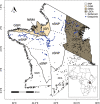Consequences of climate-induced vegetation changes exceed those of human disturbance for wild impala in the Serengeti ecosystem
- PMID: 32477568
- PMCID: PMC7246078
- DOI: 10.1093/conphys/coz117
Consequences of climate-induced vegetation changes exceed those of human disturbance for wild impala in the Serengeti ecosystem
Abstract
In East Africa, climate change is predicted to reduce vegetation quality, and pervasive human disturbance has already resulted in significant declines in biodiversity. We studied the combined effects of reduced forage quality and human disturbance on faecal glucocorticoid metabolite (FGM) concentrations. We predicted that decreasing nutritional quality and increasing human disturbance would have an additive positive effect on FGM levels in wild impala (Aepyceros melampus). Employing a space-for-time approach, we used normalized difference vegetation index (NDVI) as a measure of forage quality, combined with spatially explicit proxies of human disturbance across areas of different protection management strategies in the Serengeti ecosystem. We collected 639 faecal samples, spread over 4 years, including both wet and dry seasons. Impala FGM levels increased significantly with declining NDVI and, to a lesser extent, with increasing proxies for human disturbance. However, we found no interaction between the two, such that impala had elevated FGM levels with low NDVI and low FGM levels with high NDVI regardless of human disturbance levels. This implies that impala will have high FGM levels if forage quality is poor, even with significant protection and reduced human disturbance. Understanding how animals respond to and cope with changes in forage quality and human land use across different protected areas is important for conservationists and managers to better protect species at risk and predict population viability.
Keywords: NDVI; conservation; cortisol; forage quality; protected areas; stress; ungulate.
© The Author(s) 2020. Published by Oxford University Press and the Society for Experimental Biology.
Figures




Similar articles
-
Differing physiological and behavioral responses to anthropogenic factors between resident and non-resident African elephants at Mpala Ranch, Laikipia County, Kenya.PeerJ. 2020 Sep 28;8:e10010. doi: 10.7717/peerj.10010. eCollection 2020. PeerJ. 2020. PMID: 33062433 Free PMC article.
-
Stress as a facilitator? Territorial male impala have higher glucocorticoid levels than bachelors.Gen Comp Endocrinol. 2020 Oct 1;297:113553. doi: 10.1016/j.ygcen.2020.113553. Epub 2020 Jul 18. Gen Comp Endocrinol. 2020. PMID: 32687935
-
Between hunter and climate: the effects of hunting and environmental change on fecal glucocorticoid metabolite levels in two sympatric ungulate species in the Ruaha-Rungwa ecosystem, Tanzania.Conserv Physiol. 2023 Feb 7;11(1):coad002. doi: 10.1093/conphys/coad002. eCollection 2023. Conserv Physiol. 2023. PMID: 38026801 Free PMC article.
-
Grouping behaviour and activity patterns of impala (Aepyceros melampus) in a nutrient -rich and a nutrient-poor savanna in Tanzania.Heliyon. 2022 May 9;8(5):e09386. doi: 10.1016/j.heliyon.2022.e09386. eCollection 2022 May. Heliyon. 2022. PMID: 35586331 Free PMC article.
-
Effects of Climate Change on Land Cover Change and Vegetation Dynamics in Xinjiang, China.Int J Environ Res Public Health. 2020 Jul 6;17(13):4865. doi: 10.3390/ijerph17134865. Int J Environ Res Public Health. 2020. PMID: 32640654 Free PMC article.
Cited by
-
The Human Shield Hypothesis: Does Predator Avoidance of Humans Create Refuges for Prey?Ecol Lett. 2025 Jun;28(6):e70138. doi: 10.1111/ele.70138. Ecol Lett. 2025. PMID: 40525791 Free PMC article. Review.
-
Season-dependent impact of forage quality on stress in alpine chamois.Ecol Evol. 2023 May 1;13(5):e10045. doi: 10.1002/ece3.10045. eCollection 2023 May. Ecol Evol. 2023. PMID: 37139402 Free PMC article.
-
Differing physiological and behavioral responses to anthropogenic factors between resident and non-resident African elephants at Mpala Ranch, Laikipia County, Kenya.PeerJ. 2020 Sep 28;8:e10010. doi: 10.7717/peerj.10010. eCollection 2020. PeerJ. 2020. PMID: 33062433 Free PMC article.
-
Non-invasive Assay for Measurement of Fecal Triiodothyronine (T3) Metabolite Levels in European Mouflon (Ovis aries musimon).Front Vet Sci. 2022 May 30;9:851794. doi: 10.3389/fvets.2022.851794. eCollection 2022. Front Vet Sci. 2022. PMID: 35711806 Free PMC article.
-
Seasonal Variations of Faecal Cortisol Metabolites in Koalas in South East Queensland.Animals (Basel). 2021 May 31;11(6):1622. doi: 10.3390/ani11061622. Animals (Basel). 2021. PMID: 34072702 Free PMC article.
References
-
- Ahlering MA, Maldonado JE, Eggert LS, Fleischer RC, Western D, Brown JL (2013) Conservation outside protected areas and the effect of human-dominated landscapes on stress hormones in Savannah elephants. Conserv Biol 27, 569–575. - PubMed
-
- Ahlering MA, Millspaugh JJ, Woods RJ, Western D, Eggert LS (2011) Elevated levels of stress hormones in crop-raiding male elephants. Anim Conserv, 14 124–130.
-
- Averbeck C (2001) Population ecology of impala (Aepyceros melampus) and community-based wildlife conservation in Uganda. PhD Thesis PhD 183.
-
- Bates D, Mächler M, Bolker B, Walker S (2015) Fitting linear mixed-effects models using lme4. J Stat Softw 67: 1–48.
LinkOut - more resources
Full Text Sources

